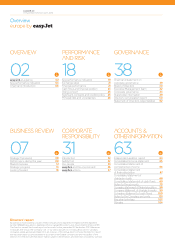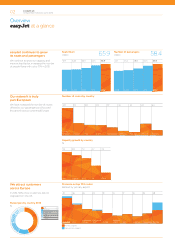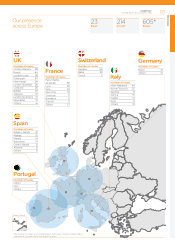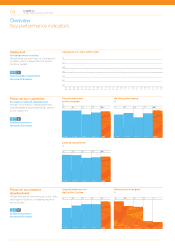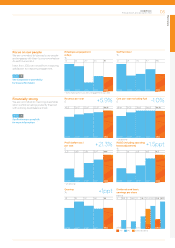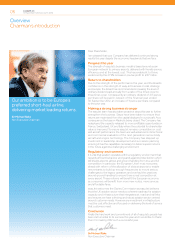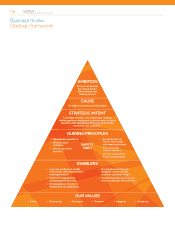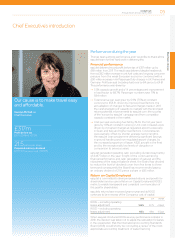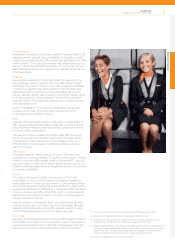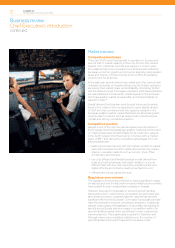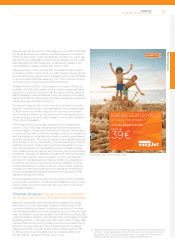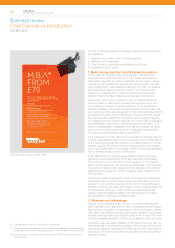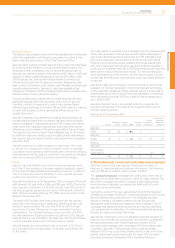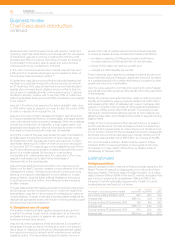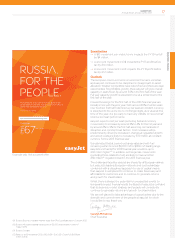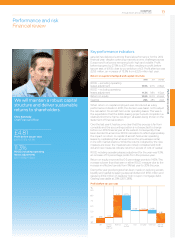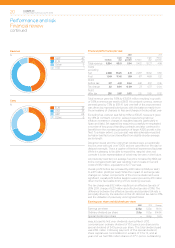EasyJet 2012 Annual Report Download - page 12
Download and view the complete annual report
Please find page 12 of the 2012 EasyJet annual report below. You can navigate through the pages in the report by either clicking on the pages listed below, or by using the keyword search tool below to find specific information within the annual report.
Over the last year it has become clear that the process is far from
complete and the accounting position is not expected to change
before 2016 at the earliest. As a consequence of the delay and
following shareholder consultation, easyJet has decided to amend
its ROCE methodology to reflect the impact on returns of aircraft
held under operating leases by capitalising them at seven times the
annual lease rental in line with market practice.
Robust operations
easyJet’s strong operational and cost performance is built around
ensuring aircraft depart and arrive on time. This both minimises the
costs of disruption, and improves customer satisfaction and repeat
purchase, which in turn increases revenue. easyJet experienced
considerably less disruption from weather and industrial action than
in previous years. In total, fewer than 1,000 flights were cancelled in
the year to 30 September 2012 compared to over 4,000 flights in
the year to 30 September 2011.
Although predominantly driven by external factors, the reduced level
of cancellations and delays is also as a result of the investment in
easyJet’s operations control centre (OCC). Initiatives launched to
drive operational performance and minimise disruption included the
easyJet turn project, the ongoing twice daily operational calls and
temporarily basing MET Office forecasters in easyJet’s head office
during the course of the Olympics.
On-time performance (OTP) improved again in the year with a 9
percentage point improvement across the network and an increase
of 3 percentage points in the fourth quarter (1). easyJet’s OTP is
now best in-class within the industry (2).
OTP % arrivals within
15 minutes Q1 Q2 Q3 Q4 Full year
2011 65% 81% 84% 85% 79%
2012 88% 90% 87% 88% 88%
The focus of the operations team in the coming financial year will
be on aircraft turn time during the roll-out of allocated seating whilst
continuing to control cost through standardisation and simplification.
Customer satisfaction
The strong operational performance was reflected in improvements
in customer satisfaction, with a 3 percentage point year-on-year
improvement satisfaction to 82%(3) and a 2 percentage points
improvement in the likelihood to recommend score to 84%.
easyJet closely monitors customer satisfaction and strives to
maintain or grow its customer satisfaction scores through making
travel easy and affordable for its customers. easyJet made further
improvements to its end-to-end customer experience such as the
decision to roll-out allocated seating across the network following its
successful trial this summer. The decision to trial allocated seating
was prompted by scores for the boarding experience which were
lower than the other categories monitored.
Country review
UK
easyJet is the largest carrier in the UK with a market share of
around 20%(4) in the total intra-European market and around 35%
share in easyJet’s markets. easyJet has further increased its total
UK market share by around 1% in the last year, largely due to other
carriers reducing capacity. easyJet saw growth at Gatwick and in its
new base at Southend, while bases in Stansted and Liverpool were
reduced. easyJet is the number one carrier in nine out of eleven UK
easyJet bases with the total number of UK based aircraft at 122.
Example only. Not a current offer.
Business review
Chief Executive’s introduction
continued
easyJet plc
Annual report and accounts 2012
10


